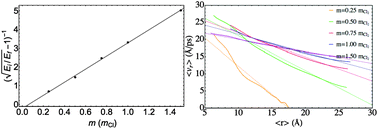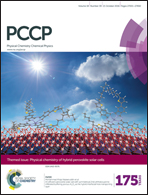Mass effects in the photodissociation of homonuclear diatomic molecules in helium nanodroplets: inelastic collision and viscous flow energy exchange regimes
Abstract
The influence of the mass in the photodissociation dynamics of a homonuclear diatomic molecule (X2), embedded in a superfluid helium nanodroplet (T = 0.37 K) of 300 atoms, has been investigated using a hybrid quantum dynamics method recently proposed by us. Several hypothetical isotopic variants of Cl2 have been examined in order to make possible the analysis of a wide diversity of masses (mX: 0.25mCl–1.50mCl). This is probably the first time that this problem has been considered theoretically. The photodissociation mechanism of X2(B) is very similar to that of Cl2(B) and the efficiency of the X2–helium energy exchange mechanism can be so great that it leads to the full and partial (≈86%) geminate recombination for the lower masses explored (mX = 0.25mCl and 0.50mCl, respectively). From the energy exchange perspective two dynamic regimes have been identified. The first regime occurs at the initial times of the photodissociation and corresponds to a perfectly inelastic collision (IC) between the atomic fragments (X) and some helium atoms of the solvation shell. The second regime occurs when the atomic fragments are moving through the nanodroplet, which behaves as a viscous fluid (VF). The ICVF mechanism has probably general character in the photodissociation of molecules embedded in superfluid helium nanodroplets.


 Please wait while we load your content...
Please wait while we load your content...